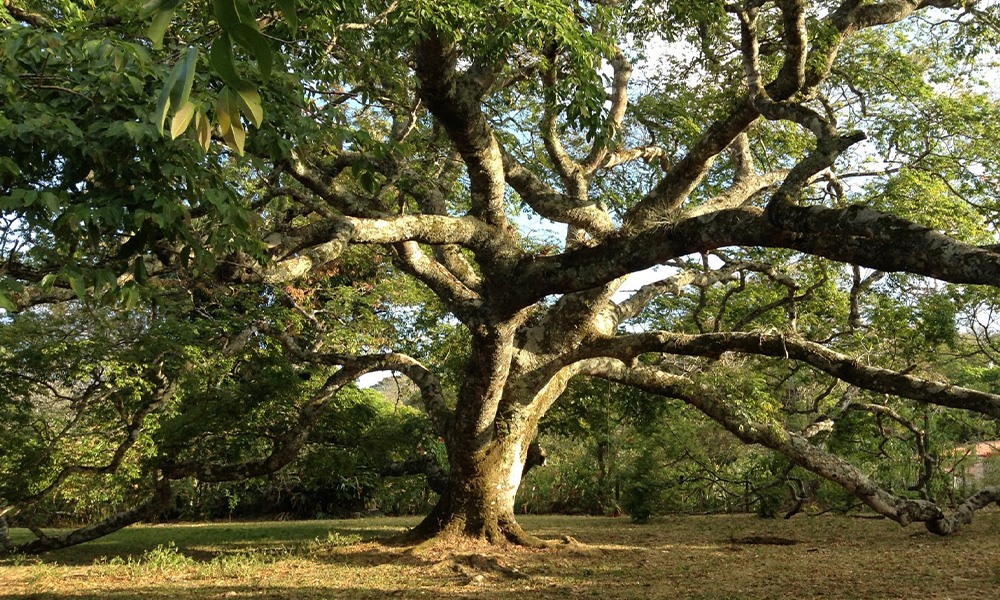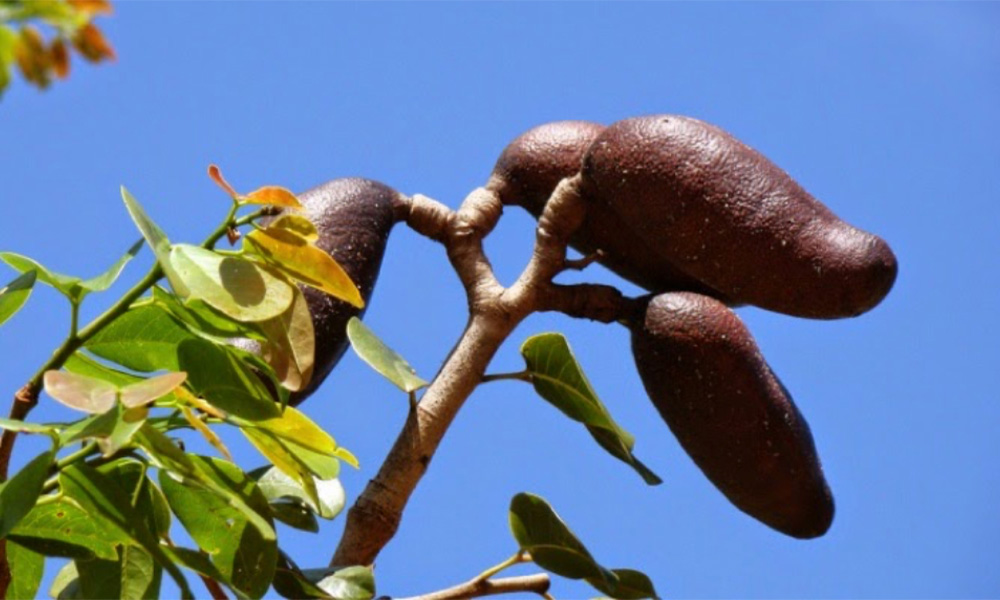
If you’ve hiked through Costa Rica’s Pacific forests, you might have spotted a massive tree with a straight trunk and wide crown. That’s the guapinol, or Hymenaea courbaril. This tree stands out in our landscapes, growing tall and providing shade, wood, and even food. People here have relied on it for generations, from building homes to treating ailments. Let’s look at what makes the guapinol special in Costa Rica.
What Does the Guapinol Look Like?
The guapinol grows into a giant, often reaching 30 to 40 meters high, with some hitting 50 meters in older forests. Its trunk stays straight and branch-free for the first 10 to 20 meters, then spreads into an umbrella-like top. The bark appears smooth and grayish, sometimes peeling in patches. Leaves come in pairs, shiny and oval-shaped, about 5 to 10 centimeters long. They stay green year-round, even during dry months, which helps the tree stand out in places like Guanacaste where other trees drop leaves.
In Costa Rica, guapinol trees prefer the Pacific side, from dry forests in the north to wetter areas farther south. They do best on slopes and ridges with good drainage, from sea level up to around 900 meters. You find them in national parks like Manuel Antonio and Santa Rosa, where they tower over the canopy. These trees handle different rain patterns well – six months dry in the north or shorter spells in the central Pacific. Their roots grip the soil firmly, without big buttresses, making them stable on hilly ground.
When It Flowers and Fruits
Guapinol trees flower between February and May, covering branches in white blooms clustered in groups up to 12 centimeters long. Bees and wasps buzz around them during the day, while bats visit at night to pollinate. Not every tree fruits each year – some skip seasons to build energy. Fruits form one to two months after flowers, staying on the tree for seven to ten months before dropping.
The pods measure 5 to 15 centimeters, hard and woody, turning from green to dark brown. Inside, a few seeds sit in a dry, powdery pulp. That pulp tastes sweet, like flour mixed with cinnamon, but it smells strong – some call it “stinking toe” for that reason. In rural areas, people crack open the pods to eat the pulp raw or mix it into drinks. Fruits hit the ground from July to March, drawing animals like agoutis and pacas that scatter seeds.
Everyday Uses in Costa Rica
Costa Ricans put the guapinol to work in many ways. Its wood ranks among the hardest, with a deep red color that shines when polished. Carpenters use it for floors, furniture, and doors because it resists rot and insects. In fact, it’s exported as “Brazilian cherry” for high-end building, though it comes from the legume family, not cherries. The density makes it heavy – about 800 to 900 kilograms per cubic meter – so it lasts in humid spots.
The fruit pulp serves as food. Mix it with water or milk for a refreshing drink, or add it to custards and ice cream for a nutty flavor. Kids in coastal towns sometimes snack on it straight from the pod. It’s nutritious, packed with carbs and some protein, though the smell turns off newcomers.
Resin from the bark, called copal or animé, has practical roles too. It hardens into amber-like chunks, used in varnishes or incense. Ancient samples from guapinol trees trap insects, giving scientists clues about past ecosystems. In crafts, people shape it into jewelry or decorations.
Medicine draws from the tree as well. Bark brews into tea to fight parasites, ease stomach issues, or treat urinary problems. Leaves and resin help with pain, inflammation, and coughs. Studies show it has antibacterial and antioxidant effects, useful for diabetes control or wound healing. In traditional practices, it’s a go-to for dysentery and hypertension.
Here’s a quick table of common uses:
| Part of Tree | Use | Examples in Costa Rica |
|---|---|---|
| Wood | Construction and crafts | Furniture, flooring, tools |
| Fruit Pulp | Food | Drinks, snacks, desserts |
| Resin | Coatings and scents | Varnish, incense, jewelry |
| Bark/Leaves | Medicine | Teas for digestion, anti-inflammatory remedies |
This table shows how one tree supplies multiple needs, from daily life to health.
Its Role in Nature
Guapinol trees support wildlife. Flowers feed pollinators, boosting honey production in nearby hives. Fruits attract rodents and monkeys that eat the pulp and drop seeds far away, helping new trees grow. In dry seasons, the evergreen leaves offer shade and moisture for understory plants.
But challenges exist. Weevils like Rhinochenus species bore into pods, eating seeds before they fall. This limits reproduction in some areas. Trees in Costa Rica often wait longer between big fruit crops compared to places without these pests, like Puerto Rico. Still, guapinol adapts, producing extra resin in pods to deter bugs.
In forests, it mixes with other natives like espavel or cenízaro, creating diverse habitats. As an emergent tree, it rises above others, shaping the skyline.
Threats and Protection
While not listed as endangered, guapinol faces pressure from logging. Its valuable wood leads to overcutting in some spots, reducing numbers in lowlands. In Costa Rica, it’s not super common everywhere – more scattered along the Pacific coast and Huetar Norte region. Deforestation for farms or development shrinks its range.
Parks protect many guapinol trees. In Guanacaste, reforestation efforts plant them to restore dry forests. Seeds germinate well in warm, moist soil, making them good for recovery projects. Groups focus on sustainable harvesting, taking wood only from managed areas.
You can help by planting guapinol on farms or yards if space allows. It grows slowly at first, leaning sideways for a couple years before straightening, but once established, it thrives with little care.
Wrapping It Up
The Guapinol embodies Costa Rica’s rich forests – tough, useful, and tied to our culture. From providing timber that builds homes to fruits that feed families, it plays a key part in daily life. Next time you’re in a park or on a trail, look up for that tall trunk and wide crown. It’s more than a tree; it’s a piece of our natural heritage. If you try the fruit, brace for the smell – the taste makes up for it.

